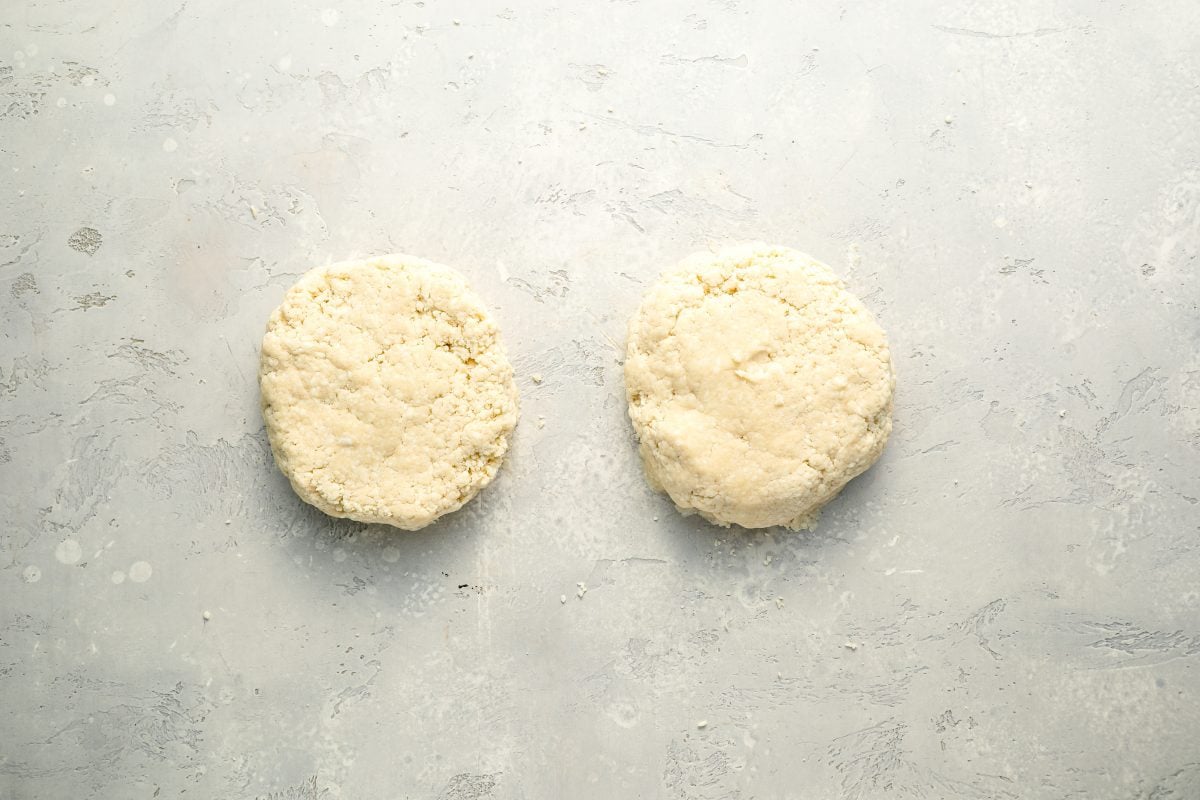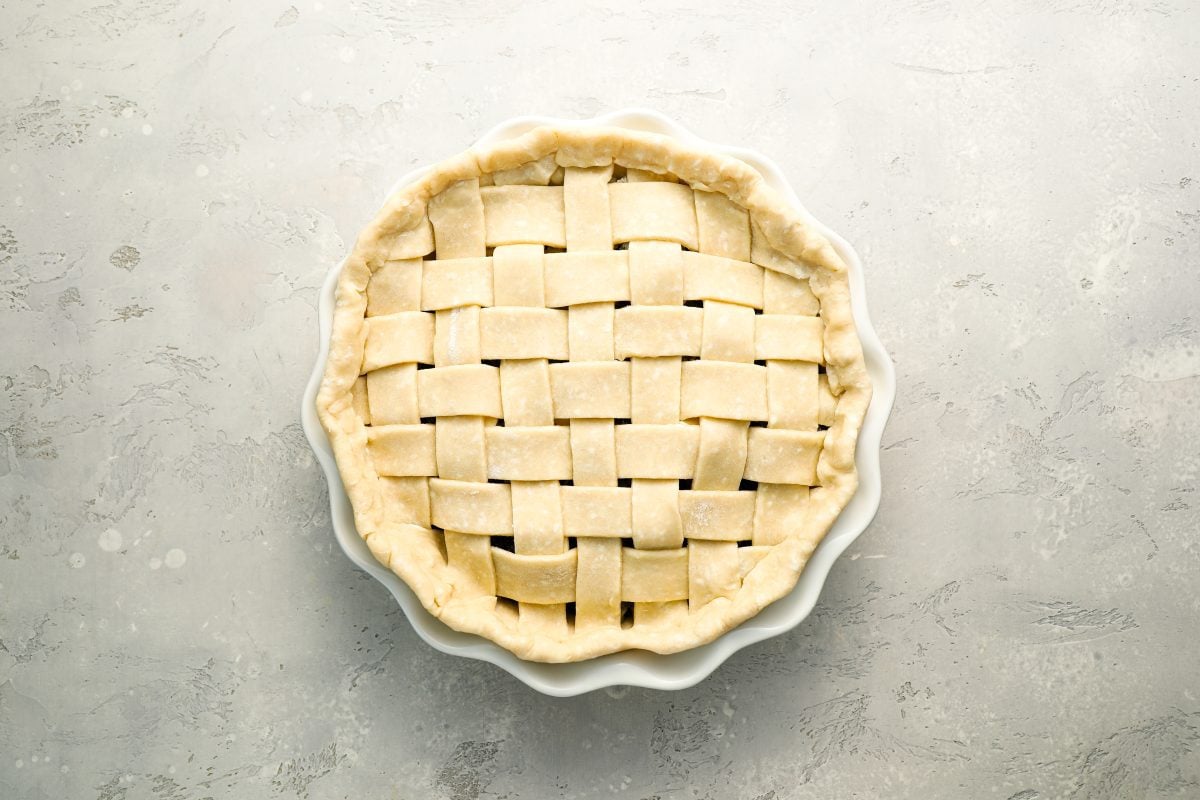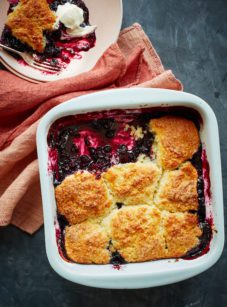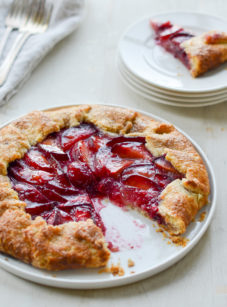Blueberry Pie
This post may contain affiliate links. Read my full disclosure policy.
Celebrate summer with a homemade blueberry pie, complete with a buttery lattice crust and tart-sweet filling that’s pure perfection.

Is there any dessert that screams summer quite like homemade blueberry pie? This version, adapted from pastry chef Stella Parks, has it all: a buttery, flaky crust with a pretty lattice top and a filling that’s the perfect balance of tart and sweet. Now, I know blueberry pies can be a bit tricky, with common pitfalls like a soupy filling or an underbaked crust, but don’t worry—this recipe is designed to avoid those issues. The filling is packed with fresh (or frozen) blueberries, brightened with a hint of lemon, and thickened with tapioca flour to ensure it sets up perfectly. And baking the pie until the center is bubbling ensures a perfectly crisp crust and beautifully sliceable pie every time.
A few pointers for success: Let the pie cool completely before slicing—I know it’s hard to resist digging right in, but patience ensures that the slices hold together when served. If you’d like to get a head start, feel free to make the crust ahead of time or freeze the whole pie to bake later. Serve the pie with vanilla ice cream, whipped cream, or simply with a cup of coffee.
What You’ll Need To Make Blueberry Pie

- All-Purpose Flour: Provides the essential structure and stability needed for the crust. Measure by spooning it into the measuring cup and leveling it off to ensure accuracy.
- Sugar: Adds a touch of sweetness to the crust and balances out the natural tartness of the blueberries in the filling.
- Baking Powder: Helps create a light, flaky texture in the crust, making it tender and airy.
- Butter: Adds richness and flakiness to the crust, while also contributing to the filling’s flavor and texture when dotted on top.
- Ice Cold Water: Binds the dough together. The temperature of the water helps keep the butter cold. This ensures the crust will come out flaky and tender.
- Blueberries: The star ingredient, providing a tart/sweet, juicy filling bursting with natural flavor.
- Lemon Zest and Lemon Juice: Adds brightness, complementing the sweetness of the blueberries and enhancing their flavor.
- Tapioca Flour: Thickens the filling, ensuring it’s not too runny and has a perfect, sliceable consistency.
- Jump to the printable recipe for precise measurements
Step-By-Step Instructions
Step 1: Prepare the Crust
If using a food processor
Combine the flour, sugar, salt, and baking powder in the bowl of a food processor fitted with the metal blade. Pulse a few times to combine.

Add the butter cubes.

Pulse until the mixture is crumbly with lots of pea-size clumps of butter within.

Add the water and pulse until the mixture is evenly moistened and very crumbly.

Dump the dough crumbles onto a clean work surface and divide into two even piles.

Make two balls of dough and pat each one into a 5-inch disc. Wrap the discs in plastic and refrigerate for at least 45 minutes and up to 3 days.

If making by hand: In a large mixing bowl, whisk together the flour, sugar, salt, and baking powder. Add the butter cubes and use a pastry cutter or two knives to cut the butter into the dry ingredients until the mixture resembles coarse crumbs. Gradually add the ice water, mixing with a fork, and then your hands, until the dough comes together into a ball. Divide into two balls of dough and pat each into a 5-inch disc. Wrap the discs in plastic and refrigerate for at least 45 minutes and up to 3 days.
Step 2: Prepare the Filling
In a large bowl, combine the blueberries, lemon zest, lemon juice, sugar, salt, and tapioca flour. Toss until combined; don’t worry if the mixture is powdery.

Preheat the Oven: Preheat the oven to 425°F and set an oven rack in the lower third position. Line a baking sheet with aluminum foil (the foil will catch the juices that bubble over from the pie, making for easy clean up).
Prepare the Bottom Crust
Remove one disc of dough from the refrigerator. Lightly dust a clean work surface with flour and place the dough on it; sprinkle a bit of flour over the dough as well. Gently knead the dough with your hands just until it becomes soft and malleable (avoid overworking it—you want it just supple enough to roll out). Roll the dough out into a 13-inch circle, adding more flour as needed to prevent sticking.

Carefully lift the dough by draping it over your rolling pin and transfer it to a 9-inch deep-dish pie pan (it should be 2 inches deep).

Gently press the dough into the pan, making sure to ease it into place without stretching. Trim the edges of the dough to extend about ½ inch beyond the pie pan’s lip.

Step 4: Fill the Pie
Transfer the filling into the crust and press into an even layer (do not mound).

Dot the berries with the butter cubes. Refrigerate while you prepare the top crust.

Step 5: Prepare the Lattice Top Crust
Remove the top disc of dough from the refrigerator and roll it out into a 10×15-inch rectangle, following the same process described earlier.

Using a pizza or pastry cutter, trim the edges and then cut the dough into 14 one-inch-wide strips.

Retrieve the filled pie from the refrigerator. Lay half of the strips horizontally over the pie filling, leaving about 1/2 inch of space between each strip.

Fold back every other strip halfway over itself. Place one strip of dough vertically over the unfolded strips.

Unfold the folded strips over the new strip, then fold back the alternating strips that were previously left unfolded.

Lay another strip of dough parallel to the first vertical strip, about 1/2 inch away from it.

Repeat the process, folding back the strips as necessary, until the lattice crust covers the entire pie.

Trim any excess dough from the edges of the lattice strips, leaving a slight overhang. Fold the edges of the bottom crust over the lattice strips.

Crimp or flute the edges to seal the pie.

Place the pie on the lined baking sheet.

Bake at 425°F for 20 minutes. Reduce the oven temperature to 375°F and continue baking for an additional 60 to 70 minutes, or until the crust is golden brown and the filling is bubbling both on the edges and in the center (if you have a digital thermometer, it should be at least 213°F in the center). Keep an eye on the pie during the second half of baking and tent lightly with foil if it’s getting too brown on top (I usually tent it at the 40-minute mark in the second phase).

Immediately move the hot pie off the foil and place on a heat-proof surface. If necessary, take a wad of wet paper towels and wipe any blueberry juice from the edges (it gets extremely sticky as it dries). Let the pie cool completely before slicing, at least 8 hours or overnight (if you have a digital thermometer, it should be 78°F or lower in the center before slicing). Resist the temptation to cut into the pie while it’s even slightly warm, or you will end up with blueberry soup!

Once cooled, you can keep the pie at room temperature for up to 2 days, covering it loosely with foil to prevent it from drying out. If you need to store the pie for longer than 2 days, place it in the refrigerator, covered with plastic wrap or aluminum foil, and store for up to 4 days.
Video Tutorial
Frequently Asked Questions
Yes, blueberry pie keeps well for 2 days at room temperature Cover it loosely with aluminum foil so it doesn’t dry out.
Sure! Prepare and assemble the pie without baking. Before wrapping, chill the pie in the refrigerator until it is cold and firm. Then, wrap the unbaked pie tightly in plastic wrap to ensure it’s well-sealed, and wrap it again in aluminum foil for extra protection. Store in the freezer for up to three months. When you’re ready to bake the pie, thaw it in the refrigerator overnight before baking.
It is absolutely essential to cook the pie until the juices are boiling in the center or the filling reaches 213°F, or it will not set up properly. Also, don’t be tempted to reduce the sugar—it is needed for the pie to set.

You May Also Like
Blueberry Pie
Ingredients
For the Crust
- 3 cups all-purpose flour, spooned into measuring cup and leveled-off
- 3 tablespoons sugar
- 1 teaspoon salt
- ¼ teaspoon baking powder
- 2½ sticks (20 tablespoons) cold unsalted butter, sliced into 1-inch pieces
- ½ cup ice cold water
For the Filling
- 5 cups blueberries, fresh or frozen (if frozen, no need to thaw)
- 1 teaspoon lemon zest, from 1 lemon
- 2 tablespoons fresh lemon juice, from 1 lemon
- ¾ cup + 2 tablespoons sugar
- ¼ teaspoon salt
- ⅓ cup tapioca flour (also called tapioca starch), such as Bob’s Red Mill
- 2 tablespoons unsalted butter, cut into small cubes
Instructions
Prepare the Crust
- If using a food processor: Combine the flour, sugar, salt, and baking powder in the bowl of a food processor fitted with the metal blade. Pulse a few times to combine. Add the butter and pulse until the mixture is crumbly with lots of pea-size clumps of butter within. Add the water and pulse until the mixture is evenly moistened and very crumbly. Dump the dough crumbles onto a clean work surface and divide into two even piles. Make two balls of dough and pat each one into a 5-inch disc. Wrap the discs in plastic and refrigerate for at least 45 minutes and up to 3 days.
- If making by hand: In a large mixing bowl, whisk together the flour, sugar, salt, and baking powder. Add the butter and use a pastry cutter or two knives to cut the butter into the dry ingredients until the mixture resembles coarse crumbs. Gradually add the ice water, mixing with a fork, and then your hands, until the dough comes together into a ball. Divide into two balls of dough and pat each one into a 5-inch disc. Wrap the discs in plastic and refrigerate for at least 45 minutes and up to 3 days.
Prepare the Filling
- In a large bowl, combine the blueberries, lemon zest, lemon juice, sugar, salt, and tapioca flour. Toss until combined; don’t worry if the mixture is powdery.
Preheat the Oven
- Preheat the oven to 425°F (220℃) and set an oven rack in the lower third position. Line a baking sheet with aluminum foil (the foil will catch the juices that bubble over from the pie, making for easy clean up).
Prepare the Bottom Crust
- Remove one disc of dough from the refrigerator. Lightly dust a clean work surface with flour and place the dough on it; sprinkle a bit of flour over the dough as well. Gently knead the dough with your hands just until it becomes soft and malleable (avoid overworking it—you want it just supple enough to roll out). Roll the dough out into a 13-inch (33-cm) circle, adding more flour as needed to prevent sticking. Carefully lift the dough by draping it over your rolling pin and transfer it to a 9-inch (23-cm) deep-dish pie pan (it should be 2 inches/5 cm deep). Gently press the dough into the pan, making sure to ease it into place without stretching. Trim the edges of the dough to extend about ½ inch (1.25 cm) beyond the pie pan's lip.
Fill the Pie
- Transfer the filling into the crust and press into an even layer (do not mound). Dot the berries with the butter cubes. Refrigerate while you prepare the top crust.
Prepare the Lattice Top Crust
- Remove the top disc of dough from the refrigerator and roll it out into a 10x15-inch (25x38-cm) rectangle, following the same process described earlier. Using a pizza or pastry cutter, trim the edges and then cut the dough into 14 one-inch (2.5 cm)-wide strips. Retrieve the filled pie from the refrigerator. Lay half of the strips horizontally over the pie filling, leaving about 1/2 inch (1.25 cm) of space between each strip. Fold back every other strip halfway over itself. Place one strip of dough vertically over the unfolded strips. Unfold the folded strips over the new strip, then fold back the alternating strips that were previously left unfolded. Lay another strip of dough parallel to the first vertical strip, about 1/2 inch (1.25 cm) away from it. Repeat the process, folding back the strips as necessary, until the lattice crust covers the entire pie. Trim any excess dough from the edges of the lattice strips, leaving a slight overhang. Fold the edges of the bottom crust over the lattice strips, then crimp or flute the edges to seal the pie.
Bake
- Place the pie on the lined baking sheet and bake at 425°F (220℃) for 20 minutes. Reduce the oven temperature to 375°F (190℃) and continue baking for an additional 60 to 70 minutes, or until the crust is golden brown and the filling is bubbling both on the edges and in the center. If you have a digital thermometer, it should be at least 213°F (100℃) in the center. Keep an eye on the pie during the second half of baking and tent lightly with foil if it’s getting too brown on top (I usually tent it at the 40-minute mark in the second phase).
- Immediately move the hot pie off the foil and place on a heat-proof surface. If necessary, take a wad of wet paper towels and wipe any blueberry juice from the edges (it gets extremely sticky as it dries). Let the pie cool completely before slicing, at least 8 hours or overnight. If you have a digital thermometer, it should be 78°F (26℃) or lower in the center before slicing. Resist the temptation to cut into the pie while it’s even slightly warm, or you will end up with blueberry soup!
- Once cooled, you can keep the pie at room temperature for up to 2 days, covering it loosely with foil to prevent it from drying out. If you need to store the pie for longer than 2 days, place it in the refrigerator, covered with plastic wrap or aluminum foil, and store for up to 4 days.
Notes
Nutrition Information
This website is written and produced for informational purposes only. I am not a certified nutritionist and the nutritional data on this site has not been evaluated or approved by a nutritionist or the Food and Drug Administration. Nutritional information is offered as a courtesy and should not be construed as a guarantee. The data is calculated through an online nutritional calculator, Edamam.com. Although I do my best to provide accurate nutritional information, these figures should be considered estimates only. Varying factors such as product types or brands purchased, natural fluctuations in fresh produce, and the way ingredients are processed change the effective nutritional information in any given recipe. Furthermore, different online calculators provide different results depending on their own nutrition fact sources and algorithms. To obtain the most accurate nutritional information in a given recipe, you should calculate the nutritional information with the actual ingredients used in your recipe, using your preferred nutrition calculator.






After chilling the dough in the fridge, it comes out hard as a rock. There’s no way I can make it soft and malleable. What can I do about this?
Hi Elizabeth, You can let it sit out at room temp for a bit, then knead until malleable. Hope that helps!
Would quick tapioca ground into a powder in a grinder be the same as tapioca starch/powder?
Hi Corinne, I wish I could say but I really don’t know and don’t want to mislead you. Sorry!
can I use corn starch instead of tapioca starch?
I recommend sticking with tapioca flour. It creates a clear, glossy finish with a smooth texture that holds up well, even if you freeze the pie. Cornstarch, while effective, can make the filling look cloudy and may become grainy or watery.
Would this work with raspberries?
Hi Nicole, raspberries aren’t very juicy, so I don’t think they will translate well here – I’m sorry!
Thank you!